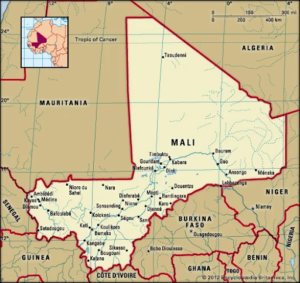In news– Recently, Mali’s army-dominated interim parliament, called the National Transitional Council, has approved a plan allowing the military government to rule for up to five years(after that Democratic transition).
Key updates-
- The army-dominated legislature also decided that the country’s interim president cannot stand for a future democratic election, as part of the same bill.
- After staging a coup in the impoverished Sahel state in August 2020, Mali’s military rulers initially promised to stage a vote in February 2022.
- But in December 2021, the military government proposed staying in power for between six months and five years, citing security concerns.
- In response, the Economic Community of West African States (ECOWAS) last month imposed a trade embargo and closed its borders with Mali.
About Mali-
- Mali is a landlocked country of western Africa, mostly in the Saharan and Sahelian regions.
- The national capital, Bamako, is located on the Niger River.
- French is the official language of Mali, but languages of the Niger-Congo family dominate.
- The area that is now Mali was once part of the three great precolonial Sudanic empires: Ghana, Mali, and Songhai.
- The Bambara (Bamana) ethnic group and language predominate, with several other groups—including the Fulani (Fulbe), Dogon, and Tuareg—also present in the population.
- The Niger River flows through its interior, functioning as the main trading and transport artery in the country.
- Mali’s landscape is largely flat and monotonous. Two basic relief features can be distinguished: plateaus and plains, which are crossed by two of Africa’s major river systems, the Niger and the Sénégal.
- Mali lies within the intertropical zone and has a hot, dry climate, with the sun near its zenith throughout most of the year.
- In general, there are two distinct seasons, dry and wet.
- There are two main vegetation zones that correspond to the climatic regions of the Sudan and the Sahel.

Source: Al Jazeera
















